一般过去式和一般将来时PPT课件
合集下载
初中英语8大时态ppt课件
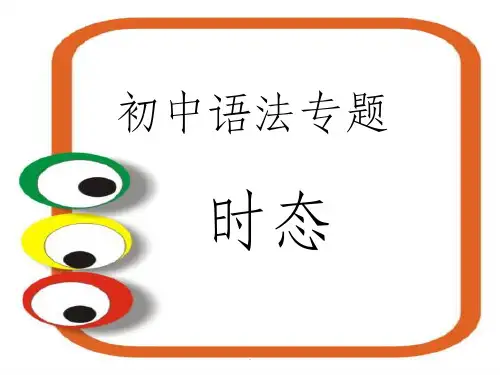
.
e.g.Has she any experience in teaching piano lessons?(√) Does she have any experience in teaching piano lessons? (√) 她有教钢琴的经验吗?
Had you a good time going hiking yesterday?(×) Did you have a good time going hiking yesterday?(√)
you/ they working?
.
Is he/ she/ it not working?或Isn’t
he/ she/ it
working?
现在分词的变法有:
1)、一般在动词词尾加上-ing , E.g. jump---jumping
2)、以不发音字母e结尾的动词,先去e,再加ing. E.g have---having
表示过去经常发生的动作,也 可用“used to do ”和“would +动词原形”。
.
肯定式
疑问式
否定式疑问否定式I源自wasateacher.
Was I a I was not
teacher? teacher.
a
Was I not a teacher?
He/ She was a
teacher.
It was Mary.
We/ You/ They
were teachers.
Were we/ We/ You/ They Were we/ you/ they not
you/ they were not/
teachers?或Weren’t we/
teachers?weren’t teachers.you/ they teacher?
e.g.Has she any experience in teaching piano lessons?(√) Does she have any experience in teaching piano lessons? (√) 她有教钢琴的经验吗?
Had you a good time going hiking yesterday?(×) Did you have a good time going hiking yesterday?(√)
you/ they working?
.
Is he/ she/ it not working?或Isn’t
he/ she/ it
working?
现在分词的变法有:
1)、一般在动词词尾加上-ing , E.g. jump---jumping
2)、以不发音字母e结尾的动词,先去e,再加ing. E.g have---having
表示过去经常发生的动作,也 可用“used to do ”和“would +动词原形”。
.
肯定式
疑问式
否定式疑问否定式I源自wasateacher.
Was I a I was not
teacher? teacher.
a
Was I not a teacher?
He/ She was a
teacher.
It was Mary.
We/ You/ They
were teachers.
Were we/ We/ You/ They Were we/ you/ they not
you/ they were not/
teachers?或Weren’t we/
teachers?weren’t teachers.you/ they teacher?
英语时态8种基本时态讲解.ppt课件

4)动词过去式变化规则。 a)一般情况下的词加-ed. work---worked call----called b)以不发音的字母e结尾的单词直接加-d . live----lived change----changed smoke----smoked die----died graduate----graduated drive----drove
8.过去完成时 表示动作发生在过去某一时间之前已经完成的动作或状态, 强调“过去的过去”, 常与 by the time, by the end of…,before , by 等引导时间的状语连用。
基本结构 主语+ had + 动词过去分词 + 其他成分 When I got to the cinema yesterday the film had begun already. He had learned English before he came here.
现在完成时与一般过去时的区别: 1)现在完成时侧重于对现在的影响;而一般过去时侧重于某一动作发生在过去某个时间或某段时间。即现在完成时侧重于现在的结果,而一般过去时侧重于动作发生的时间。例如:
I have seen the film. 我看过这部电影。(现在我仍记得电影的内容) I saw the film three days ago. 三天前我看了这部电影。(强调是三天前,而不是别的什么时候看的电影)
be going to含有“打算,准备”的意思,而will则没有这个意思, She is going to lend us her book. He will be here in half an hour.
be about to+V.原形(意为马上做某事,在时间上指最近的将来) I am about to leave school. 不能与表示时间的副词连用。 They are about to set out.(√) They are about to set,变y为i加-ed. study----studied carry----carried cry----cried try----tried d)以元音字母+y结尾的单词直接加-ed. play----played stay----stayed
8.过去完成时 表示动作发生在过去某一时间之前已经完成的动作或状态, 强调“过去的过去”, 常与 by the time, by the end of…,before , by 等引导时间的状语连用。
基本结构 主语+ had + 动词过去分词 + 其他成分 When I got to the cinema yesterday the film had begun already. He had learned English before he came here.
现在完成时与一般过去时的区别: 1)现在完成时侧重于对现在的影响;而一般过去时侧重于某一动作发生在过去某个时间或某段时间。即现在完成时侧重于现在的结果,而一般过去时侧重于动作发生的时间。例如:
I have seen the film. 我看过这部电影。(现在我仍记得电影的内容) I saw the film three days ago. 三天前我看了这部电影。(强调是三天前,而不是别的什么时候看的电影)
be going to含有“打算,准备”的意思,而will则没有这个意思, She is going to lend us her book. He will be here in half an hour.
be about to+V.原形(意为马上做某事,在时间上指最近的将来) I am about to leave school. 不能与表示时间的副词连用。 They are about to set out.(√) They are about to set,变y为i加-ed. study----studied carry----carried cry----cried try----tried d)以元音字母+y结尾的单词直接加-ed. play----played stay----stayed
初中英语六种时态复习课件(35张PPT)
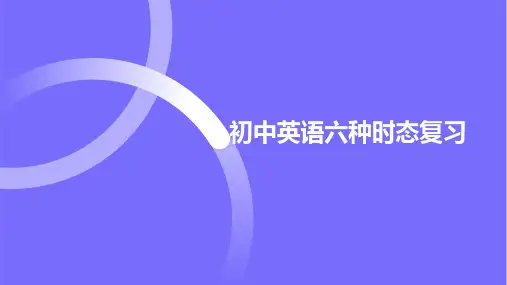
②while 引导的从句表示“在……期间”,主从句谓语动词所表示的动 作同时ቤተ መጻሕፍቲ ባይዱ生。这时,主从句都用过去进行时。
e.g.:My father was reading the newspaper while my mother was watching TV.当我的妈妈看电视的时候,我的爸爸正在看报纸。
(2)表示普遍真理或客观事实。 e.g.:The sun rises in the east.太阳从东方升起。 (3)在条件状语从句和时间状语从句中,用一般现在时表示将来。 e.g.:If it doesn't rain tomorrow,we will go for a picnic.如果明天不下 雨,我们将去野餐。 (4)在某些以 here,there 开头的句子中用一般现在时表示正在发生的动作。 e.g.:There goes the bell.铃响了。
(3)现在进行时表示将来 表示位置移动的动词 go,come,leave,fly,start,meet,move 等, 可以用现在进行时表示将要发生的事。 e.g.:We are leaving for London.我们就要动身去伦敦了。
(4)一般现在时表示将来 ①表示按规定或时间表预计要发生的动作。 e.g.:Our plane takes off at 8:10.我们的飞机 8:10 起飞。 ②当主句为一般将来时,或含有情态动词,或是祈使句时,在 if,as soon as,until,when 等引导的状语从句中用一般现在时表示将来。 e.g.:I will give him the book as soon as he comes here.他一来这儿, 我就把这本书给他。
(2)表示当前一段时间内的活动或现阶段正在进行的动作。 e.g.:They are picking apples on a farm all the time.他们一直在农场 摘苹果。 (3)与 always,usually 等词连用,表达说话人强烈的感情,如赞扬、不 满、讨厌等。 e.g.:Mary is always thinking of others instead of herself.玛丽总是为 别人着想,而不为自己着想。
一般过去时,一般现在时,一般将来时ppt课件
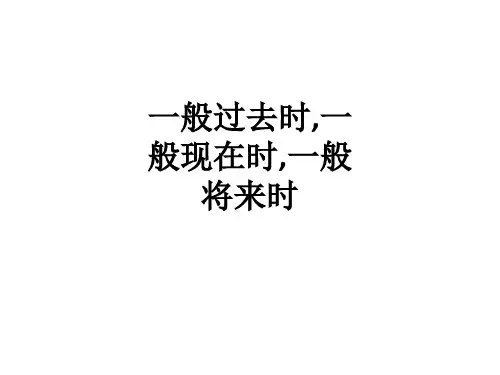
What do the elephants like eating?
4. He sends two emails every week.
How many emails does he send every week?
How often does he send two emails?
5. 5.He has lunch at school. 6. Who has lunch at school?
否定句:主语+助动词didn’t+动词原形+其它 •She didn’t do homework yesterday. 一般疑问句:Did +主语+动词原形+其它 •Did she do homework yesterday? Yes,she did./No,she didn’t.
4. 4. Daming watchs TV in the evening. watches
5. 5. Does he usually has a party? have
6. 6. What do they on do onSunday? Sunday
7. 7. Tony goes goes always to school at eight o’clock. always
8. 8. What do they eat in the party?
9. 9. Lily haves lunch at school. has
一般过去时:Past Simple
表示过去发生的动作或存在的状态
行为动词的一般过去时:
陈述句:主语+动词过去式+其它 •She did homework yesterday .
4. He sends two emails every week.
How many emails does he send every week?
How often does he send two emails?
5. 5.He has lunch at school. 6. Who has lunch at school?
否定句:主语+助动词didn’t+动词原形+其它 •She didn’t do homework yesterday. 一般疑问句:Did +主语+动词原形+其它 •Did she do homework yesterday? Yes,she did./No,she didn’t.
4. 4. Daming watchs TV in the evening. watches
5. 5. Does he usually has a party? have
6. 6. What do they on do onSunday? Sunday
7. 7. Tony goes goes always to school at eight o’clock. always
8. 8. What do they eat in the party?
9. 9. Lily haves lunch at school. has
一般过去时:Past Simple
表示过去发生的动作或存在的状态
行为动词的一般过去时:
陈述句:主语+动词过去式+其它 •She did homework yesterday .
八大时态讲解(共26张PPT)
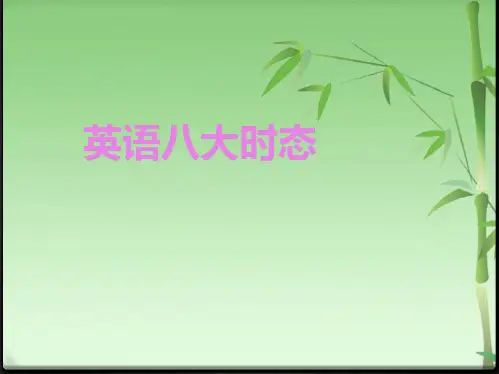
He is going to buy her some flowers.
0 一般过去将来时:
He was sixty-eight. In two years he would be seventy.
I knew you would agree.
0 现在英进行语时的: 动词时态(进行) What are you doing?
算;
如:I am going to listen to music. (我打算听音乐) will /shall 表示未事先思考或为计划过的意图
如:It will be Christmas soon .(很快就圣诞节了)
4. 现在进行时态( The Present Continuous Tense )
5、我们离开广州六年了。
We have left Guangzhou for 6 years . ×
We have been away from Guangzhou for 6
years .
3.常见句型
1) 主句(现在完成时)+since 从句(一般过去时).
2) It is +一段时间+ since 从句(一般过去时).
has gone to
He said had seen this morning, …ago, etc
that he _________the film many 如果明天不下雨,我们将去野营。
He has borrowed the pen for three days .
times. 现在进行时态( The Present Continuous Tense )
was /were going to +动词原形
0 一般过去将来时:
He was sixty-eight. In two years he would be seventy.
I knew you would agree.
0 现在英进行语时的: 动词时态(进行) What are you doing?
算;
如:I am going to listen to music. (我打算听音乐) will /shall 表示未事先思考或为计划过的意图
如:It will be Christmas soon .(很快就圣诞节了)
4. 现在进行时态( The Present Continuous Tense )
5、我们离开广州六年了。
We have left Guangzhou for 6 years . ×
We have been away from Guangzhou for 6
years .
3.常见句型
1) 主句(现在完成时)+since 从句(一般过去时).
2) It is +一段时间+ since 从句(一般过去时).
has gone to
He said had seen this morning, …ago, etc
that he _________the film many 如果明天不下雨,我们将去野营。
He has borrowed the pen for three days .
times. 现在进行时态( The Present Continuous Tense )
was /were going to +动词原形
初中英语语法课件ppt
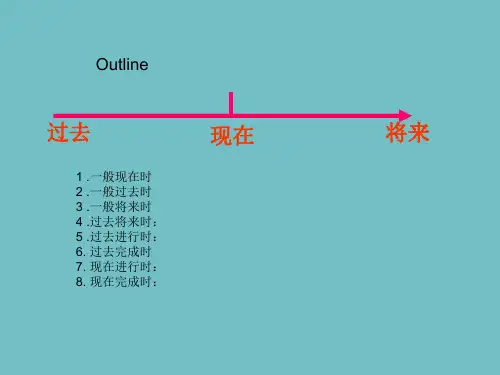
vacation together.
过去将来时的使用:
一、过去将来时表示对于过去某一时间而言将要发生的动 作或存在的状态。 would或was /were going to + V
would可用于各种人称。
二、would +V还可表示过去的习惯动作,在这点上同used to同义。
When we were children, we would/used to go swimming every summer.
e) 用于条件从句“如果……想,设想”(接近if ……want to,或 if ……should) 例:Greater efforts to increase agricultural production must be made if food shortage ____________ avoided. A) is to be B) can be C) will be D) has been
一般现在时的动词形式: 动词原形 1.am;is ;are 2.have,has 3.第三人称单数形式-(e)s
肯定句:I watch television every day.
否定句:I don’t watch television every day.
疑问句:Do you watch television every day.
一般现在时的使用:
1.一般现在时表示总是、通常、习惯 性的动作或状态。
It snows in winter. I watch television every day.
2.用于对客观事实的普遍性的陈述。
Water consists of hydrogen and oxygen. Most animals kill only for food. The world is round.
过去将来时的使用:
一、过去将来时表示对于过去某一时间而言将要发生的动 作或存在的状态。 would或was /were going to + V
would可用于各种人称。
二、would +V还可表示过去的习惯动作,在这点上同used to同义。
When we were children, we would/used to go swimming every summer.
e) 用于条件从句“如果……想,设想”(接近if ……want to,或 if ……should) 例:Greater efforts to increase agricultural production must be made if food shortage ____________ avoided. A) is to be B) can be C) will be D) has been
一般现在时的动词形式: 动词原形 1.am;is ;are 2.have,has 3.第三人称单数形式-(e)s
肯定句:I watch television every day.
否定句:I don’t watch television every day.
疑问句:Do you watch television every day.
一般现在时的使用:
1.一般现在时表示总是、通常、习惯 性的动作或状态。
It snows in winter. I watch television every day.
2.用于对客观事实的普遍性的陈述。
Water consists of hydrogen and oxygen. Most animals kill only for food. The world is round.
初中英语语法——四大基本时态课件(共24张ppt)
____(ring, ra√ng, rung).
现在进行时使用环境、句型变化
★作谓语的动词用来表示动作(情况)发生时间的 各种形式称为时态。
★概念:表示现阶段或说话时正在进行的动作及行 为。
★时间状语:Now, at this time, days, look. listen等时 间状语做标志。
★基本结构:主语+be +doing +其他 ★否定形式:主语+be +not +doing+其他 ★一般疑问句:把be动词放于句首。
事,正要做某事。 ⑤某些动词,可用进行时态表将来,如come,
现在进行时的用法
1)、现在(说话的瞬间)正在进行或发生的动作,强调“此时此刻” E.g. He is reading . They are talking now.
2)、当前一段时间内的活动或现阶段正在进行的动作。 E.g. They are working these days.
3)、 某些动词的现在进行时,表预定的计划或即将发生的动作。 E.g I am coming.
一般现在时--句型变化
❖ ③含有be动词的要在be上做变化.
❖
Danny is a good student. 陈述句
❖
丹尼是个好学生。
❖
Danny isn't a good student. 否定句
❖
丹尼不是个好学生。
❖
Is Danny a good student? 一般疑问句
❖
丹尼是个好学生吗?
此句中给出的do指“做,干”, not指把此句变为否定句, 故须在do前加助动词don't。
做题时常见错误五、对主语的数判断有误
现在进行时使用环境、句型变化
★作谓语的动词用来表示动作(情况)发生时间的 各种形式称为时态。
★概念:表示现阶段或说话时正在进行的动作及行 为。
★时间状语:Now, at this time, days, look. listen等时 间状语做标志。
★基本结构:主语+be +doing +其他 ★否定形式:主语+be +not +doing+其他 ★一般疑问句:把be动词放于句首。
事,正要做某事。 ⑤某些动词,可用进行时态表将来,如come,
现在进行时的用法
1)、现在(说话的瞬间)正在进行或发生的动作,强调“此时此刻” E.g. He is reading . They are talking now.
2)、当前一段时间内的活动或现阶段正在进行的动作。 E.g. They are working these days.
3)、 某些动词的现在进行时,表预定的计划或即将发生的动作。 E.g I am coming.
一般现在时--句型变化
❖ ③含有be动词的要在be上做变化.
❖
Danny is a good student. 陈述句
❖
丹尼是个好学生。
❖
Danny isn't a good student. 否定句
❖
丹尼不是个好学生。
❖
Is Danny a good student? 一般疑问句
❖
丹尼是个好学生吗?
此句中给出的do指“做,干”, not指把此句变为否定句, 故须在do前加助动词don't。
做题时常见错误五、对主语的数判断有误
高一英语时态讲解ppt课件.ppt
tomorrow.
(否定句)
Will I/ you/ she/ we/ they watch TV tomorrow?
(一般疑问句)
肯定回答:Yes, I/ you/ she/ we/ they will. 否定回答:No, I/ you/ she/ we/ they will not(won’t).
行 时
肯定:Yes,he/she is. 否定结:构N:o, he/she isn’t.
Sb. +is /are /am + v-ing.(肯定句)
SWb.e+/Tishne’ty//aYroenu’ta/raemwnaottc+hvin-igngT.(V 否no定w句.()肯定句)
IsW/Aer/eT+hSeby./+Yov-uinagr?e(n一’t w般a疑tc问hi句ng)TV now.(否定句) 肯A定re回w答e/t:heYeys/y, osbu. +wisa/tacrhe/inamg .TV now(?一般疑问句)
认识到了贫困户贫困的根本原因,才 能开始 对症下 药,然 后药到 病除。 近年来 国家对 扶贫工 作高度 重视, 已经展 开了“ 精准扶 贫”项 目
一般过去时
I watched TV last night
I watch TV everyday. 一般现在时
I am watching TV now. 现在进行时
一 般
肯定回答: Yes , I/we do. 否定回答:No, I/we don’t现.
He He
/ /
She She
wdoaetcshne’tswTaVtcehveTrVydeavye.r(yd肯ay定. 句()否定句)在时
英语八大时态PPT课件(详细版)
时态
A
知识导航
种类
一般现在时 一般过去时 一般将来时 现在进行时 现在完成时 过去进行时 过去完成时 过去将来时
构成
do/does did will/shall+动词原形 am/is/are + doing have/has+过去分词 was/were + doing had+过去分词 would/should+动词原 形
A
4
※表示主语所具有的特征、性格、 能力、状态等
She is a middle school student. She looks a little worried. ※某些以here/there开头的句子 中,用一般现在时表正发生的动 作
Here comes the bus.
A
5
※表示将来发生的、时刻表上不改变的事 The train leaves Hunan at five o’clock. ※特殊情况 在时间状语从句和条件状语从句中,若主 句用一般将来时,则从句用一般现在代替 将来。(主将从现)
A
21
四、一般将来时
1、构成 一般将来时态由
“will/shall+动词原形”构成,me to ask Mary for help.
A
22
2、其他表示
※be going to +动词原形:表示 说话人主观的打算或预测。 I am going to look for a job here. It is going to be a fine day for camping tomorrow.
【小试牛刀】 他们昨天这个时候正在吃晚餐。
They were having dinner this time yesterday.
A
知识导航
种类
一般现在时 一般过去时 一般将来时 现在进行时 现在完成时 过去进行时 过去完成时 过去将来时
构成
do/does did will/shall+动词原形 am/is/are + doing have/has+过去分词 was/were + doing had+过去分词 would/should+动词原 形
A
4
※表示主语所具有的特征、性格、 能力、状态等
She is a middle school student. She looks a little worried. ※某些以here/there开头的句子 中,用一般现在时表正发生的动 作
Here comes the bus.
A
5
※表示将来发生的、时刻表上不改变的事 The train leaves Hunan at five o’clock. ※特殊情况 在时间状语从句和条件状语从句中,若主 句用一般将来时,则从句用一般现在代替 将来。(主将从现)
A
21
四、一般将来时
1、构成 一般将来时态由
“will/shall+动词原形”构成,me to ask Mary for help.
A
22
2、其他表示
※be going to +动词原形:表示 说话人主观的打算或预测。 I am going to look for a job here. It is going to be a fine day for camping tomorrow.
【小试牛刀】 他们昨天这个时候正在吃晚餐。
They were having dinner this time yesterday.
(完整版)一般将来时课件(PPT)
tomorrow the day after tomorrow tomorrow morning tomorrow afternoon tomorrow evening at 7:00 tomorrow morning ……
2.与“next一家” 连用
next
time year week month term Monday at 7:00 next Sunday morning ……
6. He usually _g_e_t_s (get) up at 6 in the morning. Look! He i_s_g_e_t_t_in(gget) up now. But yesterday he _g_o_t_ (get) up very late, so he _w_e_n_t (go) to
①
②
③
① Who will have an English party next week ?
② What will they have next week ?
③ When will they have an English party?
2. be going to 表将来
will 和be going to 的区别
2.He will find some meat in the fridge soon. (变一般疑问句) W __i_ll he _f_in_d _a_n_y_ meat in the fridge?
3.She will stay there in a week. (对划线部分提问) __H_o_w _s_o_on_ w_i_ll__ she _s_t_a_y_ there?
good. 4.What time _w__ill_ you _g_e_t_ (get) to
2.与“next一家” 连用
next
time year week month term Monday at 7:00 next Sunday morning ……
6. He usually _g_e_t_s (get) up at 6 in the morning. Look! He i_s_g_e_t_t_in(gget) up now. But yesterday he _g_o_t_ (get) up very late, so he _w_e_n_t (go) to
①
②
③
① Who will have an English party next week ?
② What will they have next week ?
③ When will they have an English party?
2. be going to 表将来
will 和be going to 的区别
2.He will find some meat in the fridge soon. (变一般疑问句) W __i_ll he _f_in_d _a_n_y_ meat in the fridge?
3.She will stay there in a week. (对划线部分提问) __H_o_w _s_o_on_ w_i_ll__ she _s_t_a_y_ there?
good. 4.What time _w__ill_ you _g_e_t_ (get) to
- 1、下载文档前请自行甄别文档内容的完整性,平台不提供额外的编辑、内容补充、找答案等附加服务。
- 2、"仅部分预览"的文档,不可在线预览部分如存在完整性等问题,可反馈申请退款(可完整预览的文档不适用该条件!)。
- 3、如文档侵犯您的权益,请联系客服反馈,我们会尽快为您处理(人工客服工作时间:9:00-18:30)。
英语语法
一般过去时 一般将来时
2020年10月2日
制作人:苏祥
在初一我们学过什么 时态?
现在进行时和一般现在 时。
下面我们就来学习新 的时态一般过去时和
一般将来时
2020年10月2日
制作人:2 苏祥
什么是一般过去时?
过去所发生的行为和存在的状态。
2020年10月2日
制作人:3 苏祥
For example
2020年10月2日
制作人:9 苏祥
Exercise
1.He went (go ) to university . 2. Han dynasty(王朝)was (is) Strong and big. 3.I lived (live) in nanjing three years ago.
2020年10月2日
原形动 词 read say see stand sit take teach ……
过去式
read said saw stood sat took taught ……
词义
读 说 看见 站 坐 带 教 ……
2020年10月2日
制作人:8 苏祥
一般过去时的否定、疑问形式
否定式
疑问式
情态、联系、助动词 +be Did+主语+动词原形 did not+情态动词原形
以“辅音字母 改y为i,再加ed Studied, carried +y”结尾的词
以重读闭音节结 先双写末一个辅 Stopped, 尾,末尾只有一 音字母,再加ed planned 个辅音字母的词
2020年10月2日
制作人:6 苏祥
2)不规则动词:系词be
单
数复
数
第一人称 I
第二人称 you
第三人称
制作人:10 苏祥
什么是一般将来时?
将要发生的动作和状态.
2020年10月2日
制作人:苏祥
For example
He will go there today. 今天他将要去那里。
We going to go to SuZhou next holiday. 下个暑假我们打算去苏州。
There will be a meeting this evening . 今天晚上有个会议。 I shall not be Unemployed after university.人:14 苏祥
注意
汉语句子里表示将要发生的动作或状 态,用“将”字表达,但往往会省略, 而英语中的will&shall是不行的。
在现代英语中,will用于所有人称以 成为比较明显的趋势。
2020年10月2日
制作人:15 苏祥
演讲完毕,谢谢观看!
Thank you for reading! In order to facilitate learning and use, the content of this document can be modified, adjusted and printed at will after downloading. Welcome to download!
He worked in that factory last year. 他去年在那个工厂工作。 I was a grade school student in 1996 year . 1996年我是一个小学生。 There was no film yesterday . 昨天没有电影。
2020年10月2日
制作人:4 苏祥
一般过去时怎么构成?
1)规则动词:在原形动词后“ed” 2)不规则动词:系词be、其他不 规则动词
2020年10月2日
制作人:5 苏祥
1)规则动词:在原形动词后加“ed”
情
况加
法例
词
一般情况
加ed
Helped, played
Learned,
以字母“e”结尾 只加d 的词
Lived, saved
汇报人:XXX 汇报日期:20XX年10月10日
制作人:16 苏祥
2020年10月2日
制作人:12 苏祥
一般将来时怎么构成?
1) 助动词shall&will+动词原形
2) 2)系动词be+going to+动 词原形
2020年10月2日
制作人:苏祥
一般将来时的否定、疑问形式
否定式: 主语+will&shall+not+动词原形 疑问式: Will&shall+主语+动词原形……?
he
2020年10月2日
she it
was
we
were you
were
was
they
制作人:7 苏祥
2)不规则动词:其他不规则动词
原形动 词 come do get go have make put run
过去式
came did got went had made put ran
词义
来 做 得到 去 有 知道 放 跑
一般过去时 一般将来时
2020年10月2日
制作人:苏祥
在初一我们学过什么 时态?
现在进行时和一般现在 时。
下面我们就来学习新 的时态一般过去时和
一般将来时
2020年10月2日
制作人:2 苏祥
什么是一般过去时?
过去所发生的行为和存在的状态。
2020年10月2日
制作人:3 苏祥
For example
2020年10月2日
制作人:9 苏祥
Exercise
1.He went (go ) to university . 2. Han dynasty(王朝)was (is) Strong and big. 3.I lived (live) in nanjing three years ago.
2020年10月2日
原形动 词 read say see stand sit take teach ……
过去式
read said saw stood sat took taught ……
词义
读 说 看见 站 坐 带 教 ……
2020年10月2日
制作人:8 苏祥
一般过去时的否定、疑问形式
否定式
疑问式
情态、联系、助动词 +be Did+主语+动词原形 did not+情态动词原形
以“辅音字母 改y为i,再加ed Studied, carried +y”结尾的词
以重读闭音节结 先双写末一个辅 Stopped, 尾,末尾只有一 音字母,再加ed planned 个辅音字母的词
2020年10月2日
制作人:6 苏祥
2)不规则动词:系词be
单
数复
数
第一人称 I
第二人称 you
第三人称
制作人:10 苏祥
什么是一般将来时?
将要发生的动作和状态.
2020年10月2日
制作人:苏祥
For example
He will go there today. 今天他将要去那里。
We going to go to SuZhou next holiday. 下个暑假我们打算去苏州。
There will be a meeting this evening . 今天晚上有个会议。 I shall not be Unemployed after university.人:14 苏祥
注意
汉语句子里表示将要发生的动作或状 态,用“将”字表达,但往往会省略, 而英语中的will&shall是不行的。
在现代英语中,will用于所有人称以 成为比较明显的趋势。
2020年10月2日
制作人:15 苏祥
演讲完毕,谢谢观看!
Thank you for reading! In order to facilitate learning and use, the content of this document can be modified, adjusted and printed at will after downloading. Welcome to download!
He worked in that factory last year. 他去年在那个工厂工作。 I was a grade school student in 1996 year . 1996年我是一个小学生。 There was no film yesterday . 昨天没有电影。
2020年10月2日
制作人:4 苏祥
一般过去时怎么构成?
1)规则动词:在原形动词后“ed” 2)不规则动词:系词be、其他不 规则动词
2020年10月2日
制作人:5 苏祥
1)规则动词:在原形动词后加“ed”
情
况加
法例
词
一般情况
加ed
Helped, played
Learned,
以字母“e”结尾 只加d 的词
Lived, saved
汇报人:XXX 汇报日期:20XX年10月10日
制作人:16 苏祥
2020年10月2日
制作人:12 苏祥
一般将来时怎么构成?
1) 助动词shall&will+动词原形
2) 2)系动词be+going to+动 词原形
2020年10月2日
制作人:苏祥
一般将来时的否定、疑问形式
否定式: 主语+will&shall+not+动词原形 疑问式: Will&shall+主语+动词原形……?
he
2020年10月2日
she it
was
we
were you
were
was
they
制作人:7 苏祥
2)不规则动词:其他不规则动词
原形动 词 come do get go have make put run
过去式
came did got went had made put ran
词义
来 做 得到 去 有 知道 放 跑
